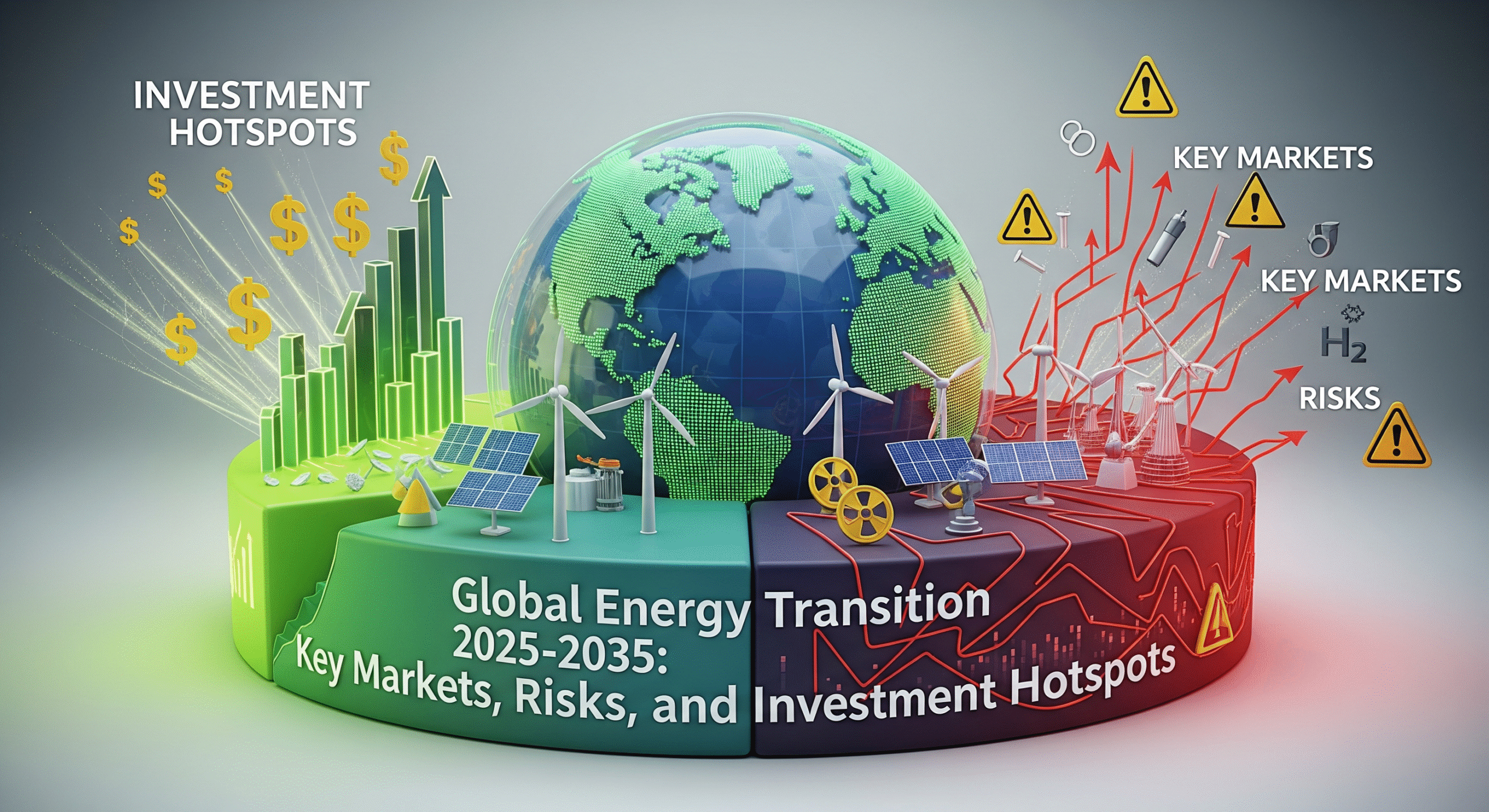Global Energy Transition 2025–2035: Key Markets, Risks, and Investment Hotspots
The global energy landscape is entering its most transformative decade. Between 2025 and 2035, the shift toward low-carbon systems will accelerate faster than any period in modern history—shaped by climate policies, cost declines in renewable technologies, supply chain realignments, and surging demand for clean power across industries.
For investors, policymakers, and energy companies, this decade will present both enormous opportunities and equally significant risks. Understanding where the market is heading—and which regions are poised to lead—will be essential for long-term success.
1. Key Drivers of the Energy Transition
1.1. Policy Pressure Intensifies
Governments are tightening climate commitments:
Over 90% of global GDP is now covered by net-zero pledges.
The U.S. Inflation Reduction Act (IRA), EU Green Deal, China’s 2060 carbon goals, and India’s 500 GW RE target are defining global market directions.
1.2. Renewable Costs Continue to Fall
Solar and wind have already achieved the lowest LCOE globally. From 2025–2035:
Solar utility costs are expected to fall an additional 20–30%.
Energy storage costs could drop 25–40% due to battery chemistry improvements and scaled manufacturing.
1.3. Corporate Clean Energy Demand Surges
Industries like steel, cement, chemicals, and data centers are drastically increasing renewable procurement to meet ESG goals.
2. Markets Leading the Transition (2025–2035)
**2.1. Asia-Pacific: The Fastest-Growing Renewable Hub
APAC will dominate solar, wind, and green hydrogen expansion.
China:
Continues its massive grid-scale solar and offshore wind rollout.
Investing heavily in long-duration energy storage.
India:
Expected to double renewable capacity by 2030.
A major future exporter of green hydrogen and ammonia.
Southeast Asia:
Emerging solar hotspots (Vietnam, Philippines, Malaysia).
Seeking financing for grid modernization.
**2.2. Europe: The Innovation and Policy Leader
Europe remains the global center for:
Offshore wind innovation
Green hydrogen pilots
Advanced grid technology
Energy efficiency mandates
The EU’s strict carbon pricing and green financing rules give Europe a competitive edge in clean tech scaling.
**2.3. North America: The Decade of Clean Infrastructure
The U.S. IRA will fuel:
Record renewable installations
EV supply chain reshoring
Large-scale carbon capture investments
Expansion of modernized grids and battery storage
Canada and Mexico will also benefit from North American supply chain reforms.
**2.4. Middle East & Africa: New Energy Exporters
These regions will evolve from traditional oil exporters to green energy suppliers.
Middle East:
Saudi Arabia, UAE, and Oman leading giga-scale green hydrogen projects.
Ultra-low solar LCOE makes them competitive exporters.
Africa:
High renewable potential but funding gaps continue.
South Africa, Morocco, Kenya emerging as key players.
3. Major Risks Ahead
3.1. Supply Chain Constraints
Critical minerals like lithium, nickel, cobalt, copper, and rare earths may face shortages. Geopolitical tensions can disrupt supply.
3.2. Grid Limitations
Many countries lack grid capacity to support rapid renewable expansion. Delays in transmission infrastructure remain a top bottleneck.
3.3. Policy Volatility
Political shifts can slow momentum—especially in countries with elections or unstable regulatory frameworks.
3.4. Financing Challenges
High interest rates and inflation may increase project costs, particularly in developing markets.
3.5. Technology Gaps
Hydrogen, carbon capture, advanced nuclear, and long-duration storage face commercial and technical hurdles.
4. Investment Hotspots (2025–2035)
4.1. Renewable Power (Solar & Wind)
Still the largest and most stable investment opportunity.
Key markets: China, India, U.S., EU, Middle East.
4.2. Battery Energy Storage Systems (BESS)
Grid reliability, peak shaving, and renewable stabilization will drive massive demand.
High-growth regions: U.S., Australia, India, U.K.
4.3. Green Hydrogen & Ammonia
Expected to reach commercial maturity by 2030.
Export leaders: Middle East, Australia, Chile.
Demand centers: EU, Japan, South Korea, India.
4.4. Carbon Capture, Utilization & Storage (CCUS)
Oil & gas companies leading deployment; hard-to-abate industries will follow.
Hotspots: U.S., Canada, Norway, Middle East.
4.5. EV & Battery Supply Chain
Opportunity clustering in:
U.S. (IRA incentives)
India (PLI scheme)
Europe (localization policies)
4.6. Smart Grids & Digital Energy Solutions
AI-driven energy optimization, demand forecasting, digital twins — top picks for long-term ROI.
5. The Bottom Line
Between 2025 and 2035, the energy sector will undergo a dramatic transformation—creating multi-trillion-dollar opportunities across renewables, hydrogen, battery storage, and clean infrastructure.
But success will depend on navigating supply constraints, shifting policies, and technological uncertainties.
Companies and investors that act early, diversify geographically, and leverage accurate market intelligence will be best positioned to win in this new energy era.


